Lecture
TRIZ teaches to solve inventive problems. Known - with the help of the Information Fund, unknown - with the help of ARIZ. The algorithm for solving inventive problems (ARIZ) is perhaps the most popular and effective element (and tool) of Altshuller's theory. Algorithms are a detailed and rather time-consuming description of the sequence of the inventive process that can be adopted by every person whose work is connected with creativity. But it should be noted that not only knowledge is important, but also an understanding of algorithms, as well as the practice of working with them. The author of the methodology wrote: "ARIZ is a tool for thinking, and not instead of thinking."
Since ARIZ occupies an important place in the theory of inventive problems, in this lesson we will try to answer the question: what algorithms of TRIZ are used to find the most suitable solutions and how to work with them effectively?
Content
The algorithm of G.S. Altshuller called his method in a broad, not narrow, mathematical sense. The algorithm for solving inventive problems did not require strict accuracy, such as, for example, the algorithm for extracting a square root from a positive integer number. He was very flexible: different tasks could be solved in different ways, depending not only on the conditions of the task, but also on the knowledge, experience and abilities of the inventor himself.
ARIZ is a complex program of algorithmic type, based on the laws of the development of technical systems and designed to analyze and solve inventive problems.
This is a kind of step-by-step instruction in which there are 3 parts (according to the book by V. Petrov “Algorithm for Inventive Problem Solving”):
The categorical apparatus of ARIZ is quite simple and is based on two basic concepts: contradictions and the ideal final result. Consider them in detail and illustrate with examples.
Contradictions. Contradiction is the interaction of opposing, mutually exclusive sides and tendencies, objects and phenomena, which at the same time are in inner unity. In the case of TRIZ and ARIZ, the solution of the problem is based on the sequence of identifying and resolving contradictions, eliminating their causes. ARIZ appeals to three types of contradictions, through which cause-effect relationships are identified. Their definition is necessary to understand the essence of the solution of the problem, so we consider them in more detail.
Surface contradiction (PP) - the contradiction between the need and the possibility of its satisfaction. The classical theory of G.S. Altshuller calls this contradiction administrative (AP), since it is often formulated by the administration or customer and contains a reference to the problem: “We need to increase the speed of work, but it’s not known how” it is not clear how to do this, ”etc. Surface contradiction (PP) is associated either with the elimination of the undesirable effect (NE) - that which does not suit us in the technical system, or with the need to create something new, but it is still not clear how. Example: removing a hot saucepan from the stove, you can burn yourself. How to eliminate this disadvantage?
In-depth contradiction (UE) is a contradiction between certain parts, qualities or parameters of the system. UE occurs when improving some parts (qualities or parameters) of the system, taking into account the inadmissibility of the deterioration of others, when a beneficial effect simultaneously causes a harmful one. Usually you have to look for a compromise, that is, to sacrifice something for the sake of a solution (speed of work, dimensions, etc.). Thus, a deep contradiction is the cause of the appearance of a superficial contradiction, intensifying it. GS Altshuller, pointing out that in order to solve the problem, it is necessary to change the technical characteristics of the object, he called this contradiction technical (TP). Example: the pan should heat up, because only this way is possible cooking. This conflicts with the need to remove the pan with your hands.
Aggravated contradiction (OP) - presentation of diametrically opposite properties (for example, physical) to a certain part of the technical system. It is necessary to determine the causes that gave rise to a profound contradiction, in other words, is its further deepening. Sometimes it is necessary to identify the root causes. For many strangers to ARIZ, such a formulation sounds unusual, because OP implies that a part of the vehicle must be in two mutually exclusive states at once: be cold and hot, mobile and stationary, etc. The study of the causes of the in-depth (technical) contradiction leads to the need to identify the contradictory physical properties of the system, so G. S. Altshuller called it the physical contradiction (OP). Example: the pan must be hot to cook food in it, and cold to be removed by hand. But it is enough that only the bottom and the walls are hot. But the handles can be made of insulating material. So we come to a solution.
The ideal end result (IFR) is a solution that we would like to see in our wildest dreams, when absolutely everything is possible. RBI is an ideal system, the efficiency of which is 100%. Altshuller suggested that the most effective solution to a problem is one that is achieved “by itself” only at the expense of the already available resources. He defined the ideal end result (IFR) as a situation when: "A certain element (X-element) of a system or environment itself eliminates the harmful effects, while retaining the ability to perform useful things."
Thus, the essence of ARIZ is to identify a contradiction on the basis of a comparison of the ideal and real state of the vehicle and eliminate it. For this it is important that the inventor develops associative thinking, which can be trained, including with the help of our game "Chain of Associations".
This game aims to develop associative thinking.
First you will be asked to complete ten chains of 3 words with your own association. Try to come up with an association that is very well connected with the suggested words, but no other.
After filling the chains, you need to find the extra elements in the previously built chains. Click "Start" to start the game.
Statistics Full Screen
The algorithm for solving inventive problems consists of several elements. Here is a simplified version of ARIZ.
one
First you need to determine what type of tasks ours relates to: is it research or inventive? The research task requires the description of a new phenomenon, previously unknown and incomprehensible. Inventive deals with the phenomenon known to us, which needs to be changed or eliminated. Obviously, such problems are solved more easily, so you need to be able to translate the research task into an inventive one. To do this, you need to ask the condition of the problem instead of the question “why (how) does it happen?” The question: “how to do it?” To do this, write the formulation of the inverse task according to the scheme: “System (indicate purpose) includes (list the elements ). It is necessary under the specified conditions (specify) to ensure receipt (specify the observed phenomenon). "
2
At this stage, it is necessary to formulate the contradictions and the ideal end result. There are cases when a clear definition of these two components already suggests an acceptable result. For example, the task: how to enter the hotel, so that guests do not steal things? Contradiction - theft can not be allowed, but it is impossible to keep track of things and check the baggage of people moving in. IFR - even in case of theft the hotel should not incur losses. Everything is solved simply - the cost of things in the room is initially included in the price.
3
Resources can be all that is useful for finding a solution. It is desirable that for this purpose be used those resources that are already present in the problem situation, as well as the cheapest possible resources. For example, if a truck is literally a centimeter above the bridge or road slab, it is wiser to lower the wheel a little and drive, rather than looking for a detour.
Thanks to the work towards the search for useful resources, special reference books for TRIZ have been created.
four
Apply the techniques and principles created for finding solutions in TRIZ:
five
Having received one or more solutions to the problem, you need to analyze them from the perspective of ideality. To do this, you need to find out how difficult and expensive it will be to implement, whether all system resources are involved, what undesirable effects have arisen, how to minimize or eliminate them.
ARIZ requires an exact statement of the problem when PP, UE, RBI, OP are revealed according to the depicted chain.
PP → UE → IKR → OP → P
We already got acquainted with these concepts when we talked about terminology, therefore here we only briefly explain the connection between them for greater clarity of the scheme.
First of all, a superficial contradiction (SP) is formulated, which logically stands out from the condition of the problem. About him, as a rule, says the customer himself. Often PP is an undesirable effect that needs to be eliminated by presenting certain requirements to the system. So determine the in-depth contradiction (UE).
Further, the vehicle seems to be what it should be as a result of eliminating the undesirable effect - getting rid of the negative factor and retaining positive qualities. Thus, the RBI is formulated. When the concept of an ideal result is developed, it is compared with the current state of the system, on the basis of which the reasons for its imperfections are sought. These reasons make up the OP - a heightened contradiction, the identification and elimination of which leads to the solution of the problem.
The sequence described above is characteristic of the main modifications of ARIZ. During its existence, the algorithm has evolved and continues to evolve in the direction of formalizing and detailing the described sequence.
G.S. Altshuller in the book “The Algorithm of the Invention” wrote that he constantly improved his algorithm, having spent 25 years with this work. He tested every modification in practice, after which he corrected ARIZ. But this does not mean that all previous options, up to the last, were not working. At one time they were successfully used by the inventors, and further modifications took into account the ever-increasing experience in solving various tasks, which progressively made ARIZ more universal.
Below is a schematic representation of the main, but not all, modifications of ARIZ. A more detailed description of them and a full list can be found in the article “History of the Development of ARIZ” in the Wikibooks.
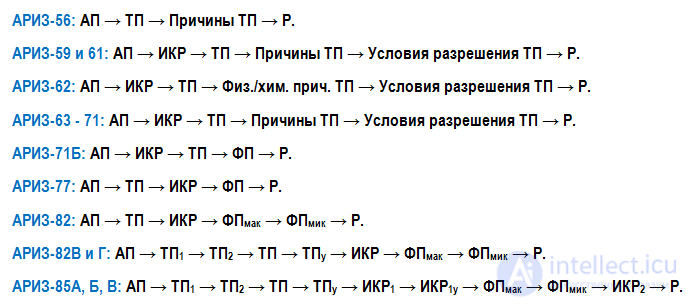
Legend:
In the process of improvement, ARIZ has adapted to the degree of difficulty of the task. The simplest tasks were solved with the help of the main chain of ARIZ (AP - TP - IFR - OP - P). Her, by the way, some modern followers of TRIZ consider the most successful and understandable. But more complex tasks required a more detailed algorithm for their solution. ARIZ-85-B, as the last modification, schematically presented above, answered this task - it is quite detailed, although, according to some TRIZ theorists, this also makes it cumbersome.
ARIZ-85-B is a rather complicated tool, so it is not recommended to use it without first studying the basics of TRIZ and thoroughly working out the types of contradictions, the main line of solving problems on ARIZ and the logic of ARIZ.
Description of the sequence of steps on the example of solving complex technical problems with the help of ARIZ-85-B is a difficult and time-consuming work. Therefore, we recommend reading the author's material placed in the sources: (see below).
All modifications of ARIZ have their drawbacks, which TRIZ practices point out and try to solve. For example, specifically in the case of ARIZ-85-B, parts 6-8 are not sufficiently developed and structured. There is also a gap in logic with the inclusion of 4 parts. In general, a part of ARIZ has yet to be developed that precisely determines the initial inventive situation and all possible solutions to the problem.
Like any other tool, ARIZ gives results largely dependent on the ability to use it. You should not think that by reading the text of the algorithm, you can immediately solve any problems. After reading the description of sambo techniques, you should not immediately go to the competition. So it is with ARIZ: single combat with a task requires practical skills.
For the synthesis of nano particles, the deposition of thin films and a number of other technological problems, it is necessary to evaporate ceramics such as Al2O3, MgO, SiO2 or their alloys.
Traditionally, arc or high-frequency induction plasmatrons are used to evaporate refractory materials. Often, the evaporation process must be carried out at low pressure, which limits the use of plasma torches, which require gas flows for their efficient operation.
Recently, lasers have been used to evaporate such materials. The main difficulty associated with the use of a laser is to provide a continuous supply of evaporated material to the focus of the laser beam.
The system for evaporation of refractory ceramics works as follows:
A ceramic material with a diameter of 2-3 mm is formed from a ceramic material. The bead is placed vertically and the laser beam is focused on its upper end. The laser operates in continuous mode, the bead moves upwards as it evaporates (see Figure 1).
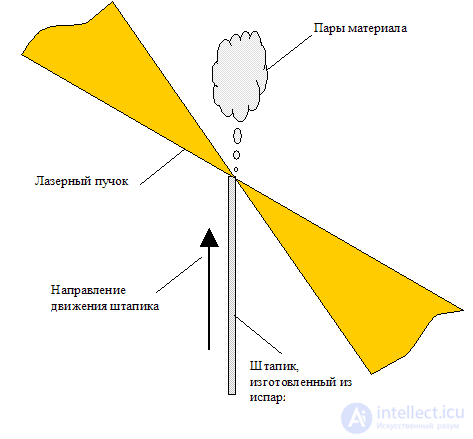
Figure 1 Diagram of the evaporation of a ceramic bead in a laser beam
Difficulties:
When exposed to a laser beam, the ceramic bead experiences a thermal shock - thermo-shock. Due to the low thermal conductivity of ceramics, thermal shock causes partial or complete destruction (cracking) of the glazing bead. There is a need for frequent replacement of damaged beadings.
Since evaporation takes place under reduced pressure, replacing the bead is a laborious process. To replace, it is necessary to raise the pressure to atmospheric, replace the bead, then reduce the pressure in the evaporator again.
Task:
How to ensure the operation of the evaporator in continuous mode: to avoid frequent replacement of beads?
Limitations:
It is impossible to move, refocus the laser beam during the operation of the evaporator. We are talking about powerful kilowatt lasers, it is known that their focusing is very complicated.
1.1. Conditions of a mini-task (without special terms)
The technical system for the evaporation of refractory materials includes a laser beam, a vaporized material in the form of a solid rod, a rod fastening system, a rod displacement system
TP-1: If the laser beam is powerful, it evaporates the rod well, but can cause its destruction and the need to replace
TP-2: If the laser beam is thin, it does not destroy the rod, but evaporates it badly
It is necessary with minimal changes in the system to ensure the operation of the evaporator in continuous mode without destroying the evaporated rods
1.2. Conflicting couple
Product - Rod
Tool - laser beam
1.3. Graphic schemes TP-1 and TP-2
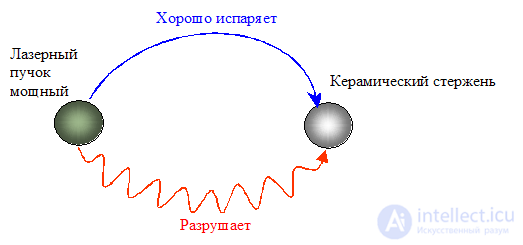
Comment: The beneficial effect of a powerful laser beam on a ceramic rod at the same time is harmful for the same rod.
Figure 2 Graphic diagram of TP-1
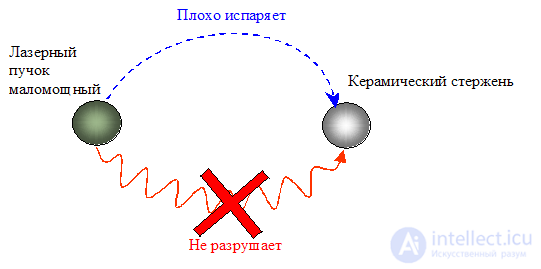
Comment: Elimination of the harmful effect of a laser beam on a ceramic rod weakens its useful effect on the same rod.
Figure 3 Graphic diagram of TP-2
1.4. TP selection
В соответствии с рекомендациями АРИЗ-85-В следует "выбрать из двух схем конфликта ту, которая обеспечивает наилучшее осуществление главного производственного процесса (основной функции технологической системы, указанной в условиях задачи). Указать, что является главным производственным процессом." [one]
В рассматриваемой задаче главным производственным процессом является испарение тугоплавкого стержня. Поэтому выбираем ТП-1: в этом случае мощный лазерный пучок хорошо испаряет стержень
1.5. Усиление ТП
В соответствии с рекомендациями АРИЗ-85-В следует "Усилить конфликт, указав предельное состояние (действие) элементов" [1]
Тогда ТП-2 переформулируется в следующем виде: Если лазерный пучок очень мощный, он хорошо испаряет стержень, но полностью его разрушает
1.6. Модель задачи
1.6.1. Конфликтующая пара: "лазерный пучок" и "керамический стержень"
1.6.2. Усиленная формулировка конфликта: Очень мощный лазерный пучок хорошо испаряет стержень, но полностью его разрушает
1.6.3. Необходимо найти такой Х-элемент, который, сохраняя способность лазерного пучка хорошо испарять керамический стержень, обеспечивал бы целостность стержня
1.7. Применение системы стандартов к решению модели задачи
Для решения данной задачи систему стандартов не применяли
2.1. Определение оперативной зоны (ОЗ)
ОЗ - это пространство, в пределах которого возникает конфликт, указанный в модели задачи [1]
В модели задачи конфликтующая пара "лазерный пучок" и "керамический стержень", испарение стержня происходит в фокусе лазерного пучка, соответственно ОЗ - фокус лазерного пучка
2.2. Определение оперативного времени (ОВ)
ОВ - это имеющиеся ресурсы времени: конфликтное время Т1 и время до конфликта Т2
В рассматриваемой задаче ОВ является суммой Т1 (время нахождения кончика стержня в фокусе лазерного пучка) и Т2 (время ввода/перемещения стержня в фокус лазерного пучка)
2.3. Определение вещественно-полевых ресурсов (ВПР)
2.3.1. Внутрисистемные ВПР
ВПР инструмента:
· Энергетическое поле лазерного пучка
· Световое поле лазерного пучка
ВПР изделия:
Комментарий: В рассматриваемой задаче нет ограничений на изменение свойств изделия - стержня, поэтому он является ВПР
· Свойства материала стержня - керамики
· Форма и размер стержня
· Положение стержня в пространстве
2.3.2. Внешнесистемные ВПР:
ВПР среды, специфичной именно для данной задачи:
· Пониженное давление воздуха
· Пары керамики в воздухе
ВПР общие для любой внешней среды:
· Гравитационное поле
· Газ
2.3.3. Надсистемные ВПР:
· Отходов посторонней системы нет
· "Копеечные" - очень дешевые посторонние элементы не обнаружены
3.1. Формулировка ИКР-1
Х-элемент, абсолютно не усложняя систему и не вызывая вредных явлений, устраняет разрушение керамического стержня в течение ОВ в пределах ОЗ, сохраняя способность лазерного пучка испарять стержень
3.2. Усиленная формулировка ИКР-1
В систему нельзя вводить новые вещества и поля, необходимо использовать ВПР.
Варианты усиленного ИКР-1:
· Энергетическое поле лазерного пучка само устраняет разрушение керамического стержня при его испарении
· Форма и размер стержня сами устраняют его разрушение при испарении
Комментарий: В процессе разбора задачи были так же сформулированы ИКР-1 с использованием внешнесистемных ресурсов: паров керамики, гравитационного поля. Однако на решения они не вывели, поэтому здесь не приводятся
3.3. Формулировка ФП на макроуровне
· Плотность подводимой мощности лазера должна быть большой, чтобы испарять стержень, и она должна быть маленькой, чтобы не разрушать стержень
· Стержень должен быть маленьким, чтобы помещаться в фокус лазерного пучка и испаряться целиком без разрушения, и стержень должен быть большим, чтобы испарение большого количества керамики происходило в непрерывном режиме
3.4. Формулировка ФП на микроуровне
В фокусе лазерного пучка должны быть частицы керамического стержня, чтобы стержень испарялся, и не должны быть, чтобы стержень не разрушался
3.5. Формулировка ИКР-2
Частицы керамического стержня должны сами появляться в фокусе лазерного пучка, чтобы происходило испарение, и частицы должны сами исчезать чтобы не передавать температурное поле в часть стержня, находящуюся не в фокусе, и не вызывать разрушение стержня
3.6. Применение системы стандартов к решению физической задачи
Для решения данной задачи систему стандартов не применяли
4.1. Метод моделирования "маленькими человечками" (ММЧ)
 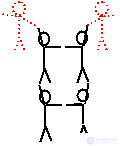 а)как было  - "человечки" керамического стержня ; - "человечки" керамического стержня ; |
 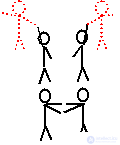 б)как стало  - " человечки" лазерного пучка - " человечки" лазерного пучка |
Figure 4 Иллюстрация конфликта с помощью ММЧ
Комментарии к Figure 4: все "человечки" керамического стержня крепко держатся друг за друга. (Figure 4 а). Когда "человечки" лазерного пучка пытаются утащить "человечков" стержня, последние удерживаются "сородичами", возникает конфликт, приводящий к разрушению стержня
Если "человечки" стержня способны образовывать небольшие группы, которые без труда утаскиваются "человечками" лазерного пучка, то конфликта, приводящего к разрушению стержня не возникает (Figure 4 б)
4.2. Из условий задачи не известно, какой должна быть готовая система
4.3. В такой постановке задача не решается применением смеси ресурсных веществ
4.4. Задача была решена заменой имеющихся ресурсных веществ пустотой. А именно, часть материала стержня была заменена пустотой. Также был использован ресурс внешней среды - гравитационное поле: испаряемую керамику было предложено подавать сверху вниз.
Было предложено подавать в фокус лазерного пучка керамический порошок. Размер частиц порошка - сотни микрометров. Порошковые питатели для дозирования таких порошков хорошо известны, недороги, просты в эксплуатации.
Достигнутый сверх-эффект: была обеспечена работа испарителя в непрерывном режиме, поскольку отпала необходимость менять штапики по мере их испарения. Дозагрузку питателя порошком можно осуществлять без отключения лазера и разгерметизации камеры испарителя.
На предложенное решение подана американская патентная заявка, опубликованная 26.07.07 [2]

Figure 5 Схема испарения керамического порошка в лазерном пучке
В тексте сохранены авторская орфография и пунктуация.
АЛГОРИТМ РЕШЕНИЯ ИЗОБРЕТАТЕЛЬСКИХ ЗАДАЧ АРИЗ-85-В
ПРИЛОЖЕНИЕ 2
СИТУАЦИЯ
При искусственном опылении растений поток воздуха от воздуходувки переносит пыльцу. Но растения в процессе эволюции выработали способность быстро закрывать цветы (смыкать лепестки) при сильном ветре. А слабый ветер плохо переносит пыльцу. How to be?
РЕШЕНИЕ
Шаг 1.1. Мини-задача. ТС для переноса пыльцы включает воздуходувку, создаваемый ею ветер, цветы (лепестки и пыльцу). ТП-1: сильный ветер хорошо переносит пыльцу, но соединяет лепестки (и пыльца не выходит). ТП-2: слабый ветер не закрывает лепестки, но и не переносит пыльцу. Необходимо при минимальных изменениях в системе обеспечить перенос пыльцы ветром воздуходувки.
Пояснение 1
По примечанию 4 следует заменить термин "ветер". Но ветер - природный элемент, изменяемый по условиям задачи. Поэтому можно сохранить слово "ветер", хотя, строго говоря, его следовало бы заменить словами "поток воздуха" или "поток частиц воздуха".
Шаг 1.2. Конфликтующая пара. Изделие - пыльца и лепестки. Инструмент-ветер (сильный, слабый).
Шаг 1.3. Схемы ТП:
|
TP-1: strong wind |
TP-2: low wind |
Step 1.4. The choice of TP. The main goal of the system is the transfer of pollen. Choose TP-1.
Step 1.5. Strengthening of TP. We assume that instead of "strong wind" in TP-1 acts "very strong wind."
Step 1.6. Task model Petals, pollen and very strong wind are given. Very strong wind tolerates pollen, but connects the petals. It is necessary to find an X-element that, while retaining the ability of a strong wind to carry pollen, would ensure a disconnected position of the petals.
Step 1.7. Application of standards
Explanation 2
The problem is solved according to the standard 1.2.4 to eliminate the harmful connection by introducing the second field (the mechanical wind field is uncontrollable by the conditions of the task, it is necessary to introduce the second field; the introduction of the third substance is unacceptable by the conditions of the task). Since we are considering the analysis of this training task for ARIZ, the standards at this step are “disabled”.
Step 2.1. Operational area. Prilepestkovoe space.
Step 2.2. Operational time. T1 - all the time the action of a very strong wind. T2 - some time before the wind.
Step 2.3. Real field resources. Air in near-space space. Mechanical field of strong wind.
Step 3.1. IFR-1. The X-element in 03, without complicating the system at all and without causing harmful phenomena, ensures that petals do not join during 0V, while retaining the ability of a very strong wind to carry pollen.
Step 3.2. Enhanced RBI-1. To enhance the ICR-1, it is necessary to replace the "X-element" with the words "air in 03".
Step 3.3. Macro-OP. The air in 03 should be “windproof” for only 0V, so that the petals are not connected, and must be “wind-conducting” so as not to interfere with the transfer of pollen.
Step 3.4. Micro-OP. The air in 03 must contain power particles for only 0V, in order not to let the wind pass, and it must not contain power particles to pass pollen.
Step 3.5. IFR-2. Force particles of air during the entire 0V should act on the petals themselves and should not act on the wind (i.e., should push the petals apart from each other and should not repel the wind).
Step 3.6. Application of standards. See the entry in step 1.7 (explanation 2).
 |
Step 4.1.
a) The essence of the conflict: in 03 there are only men of the wind A who carry pollen (this is good), but cause the petals to join (this is bad). |
 |
b) According to rule 4, it is necessary to introduce particles B, which, without interfering with particles A to carry pollen, will prevent them from connecting the petals. Particles B should be at the petals and should not occupy the rest of the space so as not to interfere with the transfer of pollen. |
Particles A are created by a blower. Where do particles B come from? You can take them from the CDF, i.e., from the air. But where does the force necessary for the separation of the petals?
 |
According to rule 6, it is necessary to divide particles B into B-1 and B-2 and obtain a disconnecting force due to the interaction of B-1 and B-2. Obviously, for this, particles B-1 and B-2 should be charged the same. |
Step 4.5. Particle production. Charged particles B-1 and B-2 can be obtained (according to rule 8) by ionization of air (or moisture contained in the air).
Step 5.4. Application of "Physical Effects Index". Daring formulas of creativity. Petrozavodsk: Karelia, 1987. P. 140. According to the table: the creation of repulsive forces (between the petals) - the use of electrostatic forces (section 4.2).
The control answer is a.s. 755247: before blowing (i.e. during T2), the petals are exposed to electrostatic charge.
Comments
To leave a comment
Theory of Inventive Problem Solving
Terms: Theory of Inventive Problem Solving